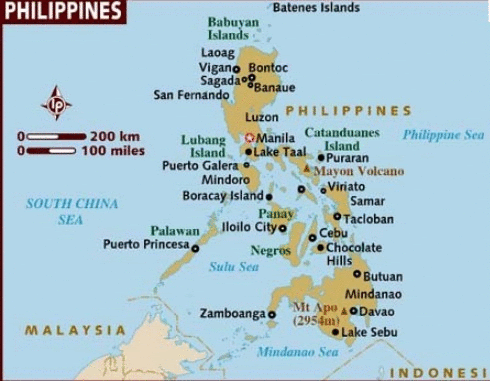Struggle for Independence:Philippines
Thursday, March 15, 2012
Trends and Similarities in Conquest and Independence
Wednesday, February 22, 2012
The Colonial Experience: What it was like for the Filipinos
Short Lived Fight for Independence
The arrest of Rizal shocked activists and in 1892, they formed the Katipunan under leader Andres Bonificio (a self-educated warehouseman). Katipunan prepared for an armed revolt and wanted to free Philipines of Spanish rule. Soon after, Emilio Aguinaldo later took over as leader. (1) In 1896, the Cavite revolution began, which led to a peace between Spain and the local Filipinos. Unfortunately, it ended shortly because neither nation respected the agreements. A new revolution took its place when the Spanish American war began in April 25, 1898. (2)
Roosevelt, who was president at the time, ordered Dewey to attack the Spanish fleet in the Philippines. The Battle of Manila Bay was the first of many. Eventually, Commodore Dewey’s ship passed under siege guns on Corregidor Island, and by noon on May 1, 1898, destroyed the Spanish fleet. (3) Prior to this date, Aguinaldo, who had left the Philippines after the peace with Spain, came back on May 19th, 1898 and continued to command his rebel forces. Dewey encouraged Aguinaldo to revolt and gave him arms to fight. The Filipino rebels, by the time the US had arrived on land, had taken the entire island of Luzon except for Manila in which they were laying siege to. (2)
From his house on Cavite (his declared capital), Aguinaldo declared independence on June 12, 1898. Meanwhile, the US stood in conflict. They hadn’t originally intended to take over the Philippines, but other imperial nations like Britain, France, Japan, and especially Germany threatened US’s place in the Asia-Pacific trade. (3) On July 1898, Spanish governor Fermin Jaudenes surrendered Manila on terms that preserved Spanish pride but totally ignored Aguinaldo. The Americans took Manila on August 13, 1898. Aguinaldo realized that the US wasn’t going to acknowledge their independence so he moved the capital to Malalos in Bulacan because it was easier to defend. (3) The Treaty of Paris declared, on December 10, 1898, the official surrender of the Philippines from Spain to the United States. Spain ceded the country they had long ruled.
Spain's Initial Conquest
U.S Re-Colonization
The US wasn’t exactly sure what do to with the Philippines. The people were also upset that the US didn’t consult them about taking over, even though Dewey had encouraged Aguinaldo to revolt. To compensate, on January 20, 1899, President McKinley appointed the First Philippine Commission (Schurman Commission) to make recommendations. (3) On January 23rd, 1899, they made the Malalos Constitution and the First Philippine Republic.
Despite the efforts, the Philippine War of Independence (first hostilities) began February 4, 1899 and lasted for two years. The US needed 126,000 soldiers. 4,234 Americans died compared to 16,000 Filipinos. 200,00 civilians died from famine and disease. (3) Aguinaldo escaped the capture of Malalos on March 31, 1899. He was driven into Northern Luzon. His troops turned to guerilla warfare (2). In May, American commander General Ewill Otis demanded unconditional surrender, but Aguinaldo kept fighting.
On March 23rd, 1901, the U.S captured Aguinaldo and he was forced to swear allegiance to the US and tell his soldiers to stop fighting. In July 4th, 1901, the U.S declared the end of military rule. (3) Even though his efforts failed, President McKinley’s Schumann Commission began to acknowledge the liberals. He realized how badly they wanted independence, and established institutions for a civilian domestic government. (5) On March 16, 1900, he appointed the Second Philippine (Taft) Commission and gave it the legislative and executive authority to use civilians. The Taft Commission abolished Spanish influence and authority and established laws and institutions of a modern civil state. The Commission established A judicial system, elective municipal government, and provincial government. The Philippine Organic Act of 1902 gave Filipinos the privilege of protection under the US Bill of Rights.
Shortly after, the Philippine Organic Act revoked Roman Catholicism as the official religion of the state and created a firm separation of church and state. In 1904, they paid the Vatican 7.2 million dollars for Church lands, which were eventually sold back to the Filipinos. Some were able to buy their land back, but most who bought it were wealthy estate owners who could afford it. (5)
Final Fight For Independence
In the first elections to the Philippine Assembly, the Nacionalista Party of Manuel Quezon and Sergio Osmena won the election and dominated electoral politics until World War II. However, they were tied to a patron-client relation and more interested in local and personal interests than larger national issues such as social reform, land ownership, tenancy rights, population growth, and wealth distribution. This excluded lower classes and non-elites, which led to resentment and revolts. The poor treatment of non-elites frustrated them. The Jones Act of 1916 elected Philippine Senate, which replaced the Philippine Commission. The Philippine Assembly was renamed the House of Representatives.
The Tydings-McDuffie Act of 1934 created the Commonwealth of the Philippines. At the end of 10 years, it would become the independent Republic of the Philippines. The Constitution was approved 1935. National independence would finally be achieved on July 4, 1946.
All in all, the fight for independence was cruel and bittersweet. During the beginning, there was much warfare that gained futile results. The Philippines achieved final independence during U.S control; it was a slow but absolute process. (5)
